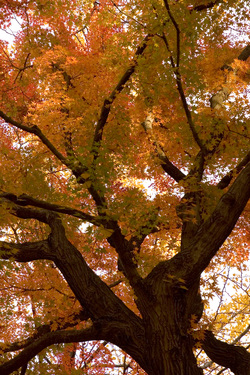 March, 2014 The property next door is set for demolition and redeveloping. The developer came to our door with a question that sent my head spinning. “Would it be alright with you if we cut down that tree?” “Say again?” “We want to build a two-car garage, and it would make things so much easier if we could remove it.” The maple tree he was pointing to is at least 75 years old and borders the two lots, so anyone would rightfully have to get our permission to cut it down. Nice of him to ask. My reaction was visceral – the gall. This shared tree is our only tree. Our kids play in the dappled light it casts over our yard and on our wood floors. On a warm summer day, the shade protects us from overheating. A slight breeze will cause a rustling and shimmering of light that is absolutely transcendent. Our maple tree, a conveyor of happiness, comfort and inspiration - the developer wanted it out of his way? I guess I shouldn’t have expected a stranger to understand, but I was incensed at the callousness of his suggestion. I confess my verbal outpouring was not very Christian. But he was relentless (he must get this all the time), trying to explain to me that a new tree would be planted in its place, of course. At that point I couldn’t hold my laughter. We thought the message – over my dead body! – had gotten through until the excavators arrived a couple weeks later, drawings in hand, and showed us, upon our request, the plans for development. They pointed to the locations of three existing trees they planned to remove, including the aforementioned object of our affections! My blood boiled again, and the excavators seemed puzzled. I called the city. No permit had been issued for the tree’s removal, and they would inform us if such an application arrived on their desk. A few days later, in a conversation with a real estate friend, he told us that some developers simply take a tree down without a permit and then pay the fine and ask forgiveness later. Praying with vague hope, I made a sign, “Do Not Damage or Remove This Tree," then added the ominous but obscure line, "Don't Wait for Forgiveness.” and then strung it up around the breast of the tree like a placard. The end of the story is still to be written, but as the saga of the maple has gone, I’m anxious about who will be writing the final chapter. I’ve come to feel caught in a cosmic battle between the forces of good and evil, with us as the guardians and the developers as the destroyers. The tree has become a symbol of helpless innocence, of purity, of God’s generosity and grace. It is not only the biosphere and carbon depletion that are at stake, though that would be enough, but the very heart of God and his love for the world were being defiled. Would it be a stretch to call our maple tree a sacrament? I don’t think so. We often assume the only sacraments are those we go to church for on Sunday morning. But I believe we are surrounded unawares by sacraments like this every day, not just as static symbols, but as means to apprehend God and as invitations to participate in his work. In fact, one could argue that the tree was among the first sacraments God gave us: The Tree of Life (Gen. 2), by which we were to draw life from God and know him. I am fearful, however. I understand how fragile these sacraments can be in a broken, self-serving world. They can be cut out of our lives with the brief hum of a chain saw, just as easily as hope can be nailed to a tree and die. To be sure, even in death we can learn of God’s grace. But I’m not ready to see that part of the story played out in our own back yard. I should prepare myself for the worst, I know, because life can be so easily snuffed out. This season, I am making the story of our maple tree my lent, waiting on God, trying to hear what he’s saying and see what he’s doing.
0 Comments
Leave a Reply. |
Archives
January 2024
Categories |
 RSS Feed
RSS Feed